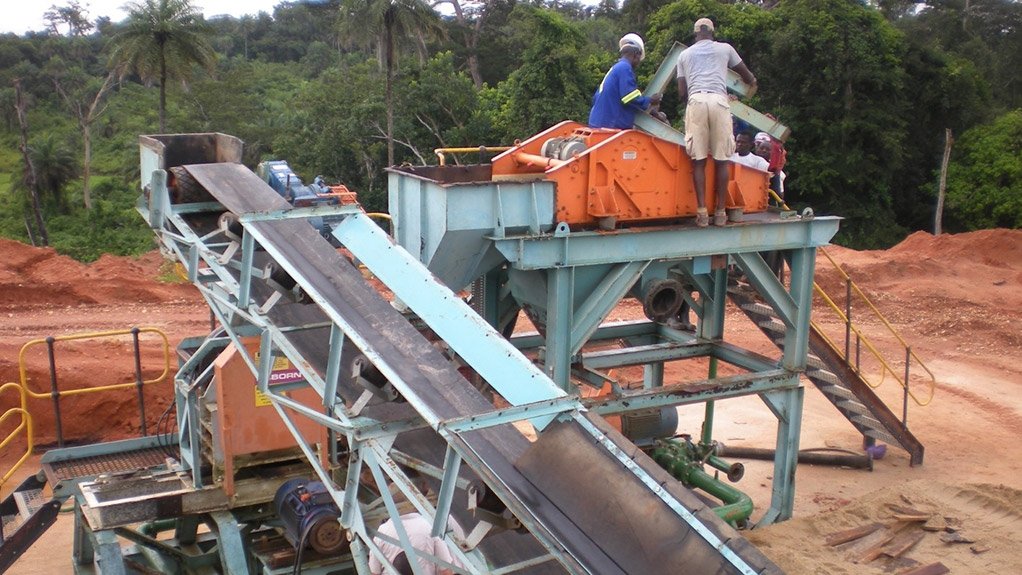Aim-listed exploration company Stellar Diamonds is moving closer to receiving the required mining and environmental licences to develop and exploit the 1.45- million-carat diamond resource at its Tongo Dyke-1, in Sierra Leone.
The company secured a meeting with the Sierra Leone Environmental Protection Agency (EPA) to discuss and agree on the fee for issuing the environmental licence for its Dyke-1 project.
The meeting with the EPA, with which Stellar says it has a professional relationship, was set for early this month.
In February, Stellar received approval of its environmental, social and health impact assessment (ESHIA) from the EPA, a “key step” in obtaining these licences, says Stellar Diamonds CEO Karl Smithson, adding that Dyke-1 is one of four kimberlite dykes at the Tongo project.
The ESHIA process involved the appointment of local and international consultants who identified the risks and mitigations for environmental impacts, such as dust and noise pollution, along with the initial local stakeholders. A draft scope report was then submitted to the EPA, with further engagements conducted upon its approval to finalise the full report.
The ESHIA cost Stellar about $75 000 upon completion.
The company states in its Tongo mine preliminary economic assessment (PEA), published in August, that the environmental team aims to be as accurate as possible in assessing the magnitude, geographic extent and duration of the environmental impact, owing to the mine’s development.
The Mines and Minerals Act of Sierra Leone requires an environmental-impact assessment (EIA) for a mining licence application, but does not require an EIA to be undertaken for an exploration licence to be issued. However, it does require an assessment before a mining licence can be issued. Although, there is a general governance requirement to conduct exploration and evaluation in an environmentally sensitive manner, explains Stellar in its PEA.
Environmentally sensitive operations are those that provide, among others, compensation for landowners for damage to crops during exploration, backfilling and improvement of safety in terms of boreholes or excavations, as well as remove any camps, temporary buildings or machinery erected and installed during exploration.
Exploration activities on the Tongo project are considered to have had minimal impact on the environment, notes Stellar, with baseline studies having been initiated during the roll-out of the ESHIA in November.
“We want to keep our footprint as small as possible. Our processing is done using dense- media separation, which is completely water- based,” adds Smithson.
The studies included monitoring soil and land use, and air and water quality to assess and document the state of the environment encompassing the project, the project’s environmental footprint and any potential impacts the project might have as it progresses along the mine life cycle.
The data will be used to assess the potential environmental risks and how they can be mitigated and will, therefore, constitute the project’s environmental management plan (EMP).
The plan also entails developing, implementing, maintaining and updating site-specific systems and focuses on issues such as the disposal of sewage, solid waste, ore and mine waste, as well as water management and rehabilitation.
Under the terms of the ESHIA, the EMP will be used to manage all environmental aspects through a system of ongoing planning, implementation, checking, corrective action and management review.
The feedback process thus generated will promote continuous improvement of environmental impacts to achieve Stellar’s objectives and targets.
Social Licence
The company highlights that it regularly engages with the local community, assisting and upgrading its socioeconomic conditions where possible. While upliftment projects are appropriate during the exploration phase, Stellar notes that the expectations in the local community will be raised as the project advances towards the mining phase.
“We are always involved in corporate social investment initiatives. As an exploration company, we did a lot for the community. Now that we are evolving into a mining company, we are increasing our initiatives. We also have a dedicated community development agreement in place, which governs where the company’s efforts should be focused,” comments Smithson.
Edited by: Tracy Hancock
Creamer Media Contributing Editor
EMAIL THIS ARTICLE SAVE THIS ARTICLE
To subscribe email subscriptions@creamermedia.co.za or click here
To advertise email advertising@creamermedia.co.za or click here













